The 10 best ski resorts in Eastern Europe
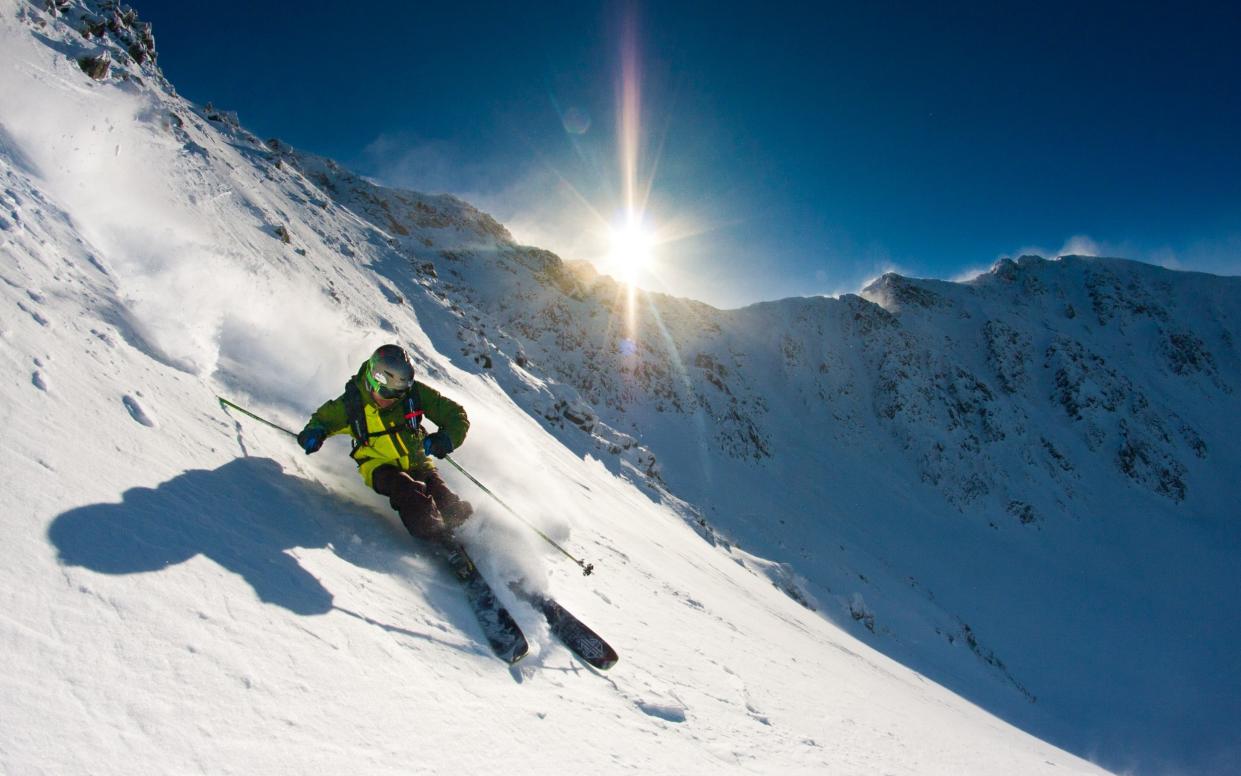
In these financially uncertain times, it might be logical to turn to new, less expensive pastures for the annual ski holiday. Destinations in Eastern Europe pride themselves on low prices – despite recent increases in the local cost of living. Visits to Bulgaria, Romania and others all look delightfully enticing when viewed online or in glossy brochures. Value is undeniable, the welcome is genuine, après-ski is lively (and cheap) and thousands of British visitors have a great time each winter.
So why don’t we all forsake Courchevel, St Anton, Zermatt and the rest, save ourselves a lot of money and go East? The main reason is that, with the noted exception of Jasná in Slovakia, almost none of these alternative destinations compare on crucial markers to even the most modest destination in the Alps. In terms of terrain, size of ski area as well as number and quality of lifts they fail to make the Alpine grade.
Just as important is the question of snow. Cover in these destinations tends to be nowhere near as reliable as in the higher resorts of France, Austria, Switzerland and Italy. The best time to visit Eastern Europe is in late January or February. For beginners, the standard of teaching is generally good, but do always insist on having a teacher who speaks good English.
However, for an affordable holiday in beautiful surroundings, with the opportunity to experience some wholly different cultures, then one of the destinations listed below fit the bill.
Zakopane, Poland
Best for beginners
Poland’s main ski resort is situated at the foot of the Tatra Mountains along the Slovak border, with train links to Poprad Tatry airport in Slovakia, which is served by direct flights from Luton airport. Zakopane’s slopes are fairly basic in challenge, best suited to beginners and low intermediates. Waterfalls, lakes and rivers add to the beautiful landscape.
Zakopane has five small ski areas covered by one lift pass, three of which are floodlit until 10pm daily. Of the three areas in and around the town, Nosal offer beginners the ideal place to learn and intermediates a chance to prepare before tackling steeper runs.

Anyone more experienced should head out of town to the other two areas. Bialka Tatrzanska is about 30 minutes by bus and offers 18km of steeper slopes, bump runs and longer pistes. Alternatively travel 2km south to Kuznice where there is a cable-car to the top of the Kasprowy Wierch peak with 11.5km of pistes, which are popular with freeriders. All the areas are linked by free ski bus.
The town itself is made up of impressive fin-de-siècle villas and contrastingly more modern buildings. Most of the action takes place on Krupowki, the main pedestrianised street which boasts an eclectic choice of restaurants and lively bars. You are never far from a band in full national dress pounding out folk music.
Where to stay
Hotel Rysy is a modern hotel set in a quiet location. Its restaurant mixes local dishes from the Tatra highlands with international cuisine. From PLN 2,485 (£957) per room, B&B, not including travel, booked direct. Luton-Poprad flights from £126 return with Wizzair.
Špindlerův Mlýn, Czech Republic
Best for intermediates
This is a recommended destination for those wanting to combine a ski or snowboard holiday with a city break in Prague or the delightful second city of Brno. It’s also the most popular ski resort in the Czech Republic’s Giant Mountains, with buildings dating back to the 1920s that retain some of the atmosphere of the era to go with it. While it has the biggest ski area of any resort in the country, Špindlerův is a low-key place with a reasonable choice of hotels and a handful of bars and restaurants.
The ski area is made up of Medvedín and Svatý Petr, which stretch out from both sides of the resort giving a total 28km of piste with 23 lifts. The pistes are mainly graded red, but there are also some blues and blacks. Other nearby ski areas (on separate lift passes), can be easily reached by ski bus.
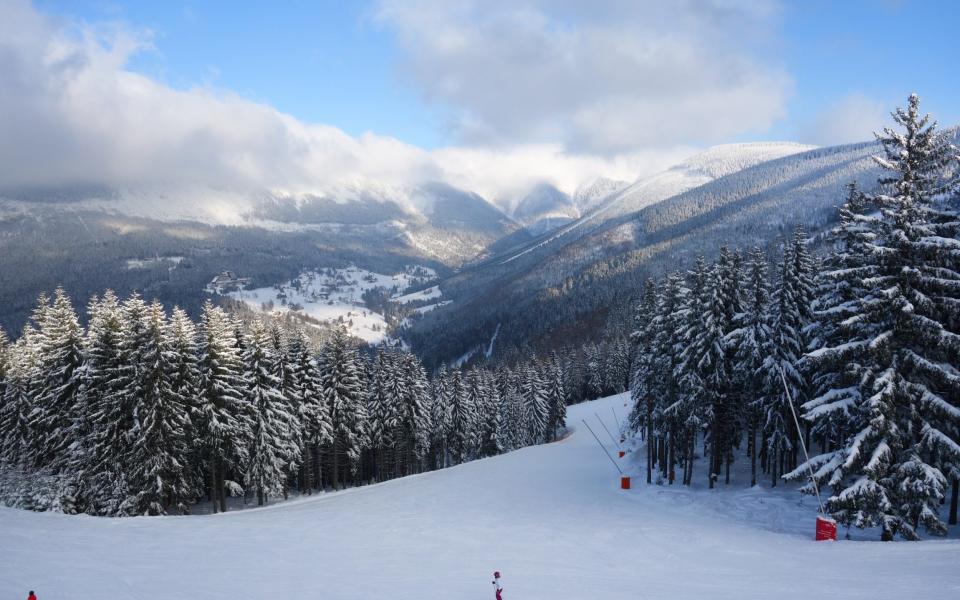
Sněžka, 7km away, is the highest highest mountain in the country, with an altitude of 1,600m, in an area of jagged stone ridges and mountain lakes and home to the source of the River Elbe.
The best way to get here is to fly to Prague, then take the train to Dolni Branna, the nearest station, 17km away, and complete the journey by taxi or local bus. .
Where to stay
Hotel Bedřichov is located near the Medvědín ski area in the northwestern part of Špindlerův Mlýn, with the Bedřiška bus stop a seven-minute walk. There’s an in-house wellness centre. From CZK12,600 (£818), B&B, including daily entrance to the Water Park. Travel not included, booked direct. easyJet return flights from £78.
Jasná, Slovakia
Best for advanced skiers
Jasná is the largest and most challenging ski area in Slovakia, offering the best all-round slopes in Eastern Europe. It’s a destination with sufficient terrain and facilities to keep even expert skiers and snowboarders blissfully happy.
From the nearest airport at Poprad, served by Wizzair from Luton, it’s a 45-minute drive to the resort, which is a small purpose-built village. Lifts rise from both sides of the mountain and hotels, shops, bars and restaurants have sprung up around these bases.

The 49km ski area is served by five modern gondolas and five high-speed chairlifts among its 28 lifts, and there is also a good choice of modern hotels and attractive restaurants. The pisted area covers both the north and south sides of 2,024m Mount Chopok.
Half the runs are intermediate level blues and reds, while 27 per cent are advanced black runs – more than in most Eastern European resorts. There are also substantial off-piste freeride zones that are mainly avalanche protected as well as two terrain parks. The south side is mostly blue and red runs while the north side accesses more challenging slopes and freeride terrain.
Where to stay
The Dragon’s Lair is a comfortable chalet sleeping 19 run by an Australian-Slovakian husband and wife team, eight-minutes’ drive from the lifts. There’s a sauna and outdoor hot tub, with massages bookable, and a bar/restaurant open to guests and the public on the ground floor. From €795 (£684), B&B, based on two sharing, including après drinks, six days equipment rental, lift shuttle, Poprad airport transfers, but not flights, with Jasna Adventures. Luton-Poprad return flights from £93 with Wizzair. Find more of the best accommodation in Jasna here
Jahorina, Bosnia-Herzegovina
Best for an all-round winter holiday
Jahorina in Bosnia-Herzegovina is perfect for a first week on the slopes, with a nursery area next to the village as well as two more up the mountain, and spacious blue runs a lift ride away. The terrain is a mixture of wide-open runs and tree-lined pistes lower down for sheltered skiing when it’s snowing. The Post Office Travel Money Ski Resort Report 2024 names Jahorina as the family resort offering the best value for money in Europe. The report was compiled in partnership with Crystal which, as it happens, is offering holidays in the resort.

As well as downhill skiing, there’s cross-country, piste-basher rides, snowmobiling, tubing, snowshoeing, and paths for winter walks. There is a choice of lunch spots up the mountain and in the resort centre, and you can expect plenty of Balkan fare – from barbequed meat to mountain stews and Turkish baklava. Although the après-ski is pretty quiet, with just a few bars, prices for drinks are some of the lowest in Europe.
Where to stay
Hotel Forest is, as its name suggests, is set in the woods, and there’s a private shuttle from here to the slopes. From £503, half board, including flights and transfers, with Crystal Ski.
Popova Sapka, Macedonia
Best for off-piste adventures
This mainly mountainous part of the former Yugoslavia has an excellent snow record and good cover is virtually guaranteed from January until March. Popova Sapka is in the north-west of the country, 90 minutes from the airport at Skopje, served by direct Wizzair flights from Luton, and is the best developed and the most popular of half a dozen little resorts in the region.
At 20km of runs the groomed ski area is tiny but the real draw here is the off piste. Some 100sq km of terrain above 1,700m makes Popova Sapka powder heaven. Croatian-born Tomislav Tiska set up snowcat operation Eskimo Freeride in 2008. His two machines take just 15 minutes to climb 900 vertical metres and take visitors up to 2,700m, from where they can expect to explore 4,000 vertical metres of untracked powder per day untracked powder, accessible only by snowcat.

A chairlift rises from the resort up to 2,510m and a choice of two easy runs comes back down or a gentle traverse heads over to a cluster of drag lifts that form most of the uphill transport. There’s a ski school and equipment rental, but Popova itself is little more than a base area, with restaurants and bars mainly in the hotels. A week on the piste would be too long for all but the wobbliest of intermediates, but combined with one or two days in the snowcats, it makes a fine alternative winter break.
Where to stay
Hotel Scardus is a four-star with two indoor pools, a spa, restaurant, and an in-house bio-organic shop. From €32,235 Denar (£453), not including travel, booked direct. Luton-Skopje return flights from £130 with Wizzair
Kranjska Gora, Slovenia
Best for western familiarity
To local disgust, Slovenia’s best-known resort is habitually described as a “poor man’s Austria”, but it is appropriate. Slovenia looks westwards rather than eastwards to the Balkans. Consequently, Kranjska Gora’s chalet-style architecture and cosy ambience closely resembles that of its more familiar neighbouring country.
The attractive village is conveniently set right at the foot of the ski area, in a pretty, flat-bottomed valley between craggy wooded mountains in the Julian Alps. The nearest airport is a 60-minute drive away at Ljubljana. Kranjska has considerable charm and a level of sophistication that puts it on a par with similarly sized Austrian or Italian resorts such as Badkleinkirchheim across the frontier in Austria and Madesimo in Italy.
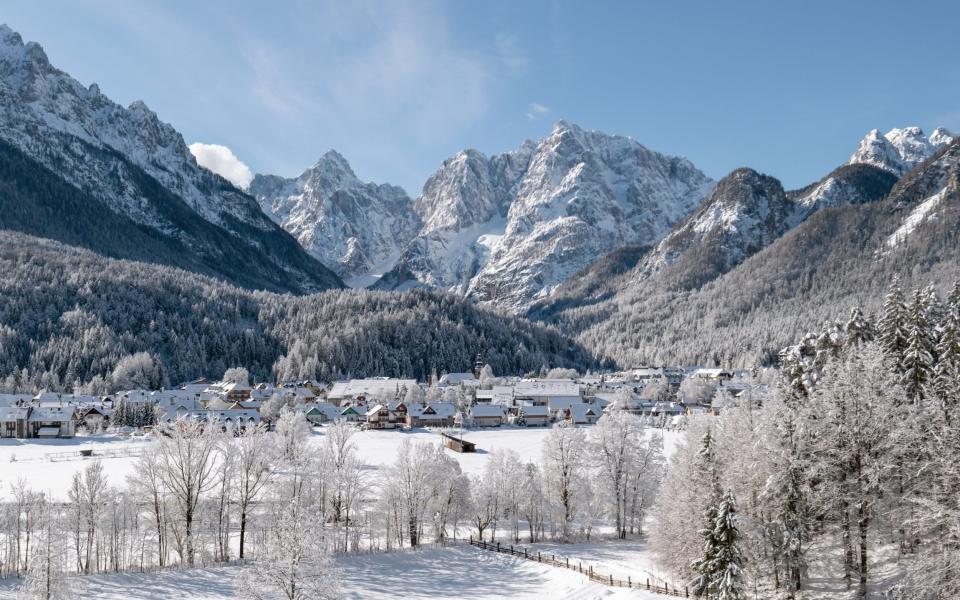
The ski area rises directly above the village, which has 20km of largely unchallenging runs, which tend to be on the short side and lack variety. The exception – snow permitting – is the steep Podkoren black run that regularly features as a slalom course for World Cup races. As in other east European resorts, snow cover is sometimes questionable, but there is extensive snowmaking.
Overall, Kranjska Gora well suits budget-conscious families with young children as the nursery slopes are central and facilities and hotels are all near the pistes. It also suits intermediates looking for lively après in high season and a good selection of restaurants at reasonable prices – but nothing too challenging on the slopes. Find more on the best-value ski resorts in Europe here.
Where to stay
Boutique Skipass Hotel is located in the beautiful Zgornjesavska Valley and offers views of the Razor, Prisank, Špik, and Tromeja peaks, as well as the Kranjska Gora ski slopes. The restaurant features fresh seafood and local game. From €1,284 (£1,111) per room, B&B, not including travel, booked direct. Return Gatwick-Ljublijana easyJet flights from £84.
Poiana Brasov, Romania
Best for apres-ski
Located in the Carpathian mountains a three-hour drive north of Bucharest, and 12km by bus from the medieval town of Brasov, Poiana Brasov is the only resort in Romania with international appeal. Dracula’s Castle is a 23km drive from the resort and worth a visit.
The country suffered appallingly at the hands of Nicolae Ceauşescu, its leader from 1965 until 1989, when he was deposed and executed. In the post-Communist era, winter sports were hampered by lack of investment, but now they’re thriving.
The country suffered appallingly at the hands of Nicolae Ceauşescu, its leader from 1965 until 1989, when he was deposed and executed. In the post-Communist era, winter sports were hampered by lack of investment, but now they’re thriving.
There’s a good choice of hotels at the base of the slopes and the standard of accommodation and quality of cuisine is high. At the weekly resort-organised barbecue, flaming bear steaks are served up with a background of folk dancing. Brasov has a good range of low-cost shops, a fine 15th-century church and lively nightlife.
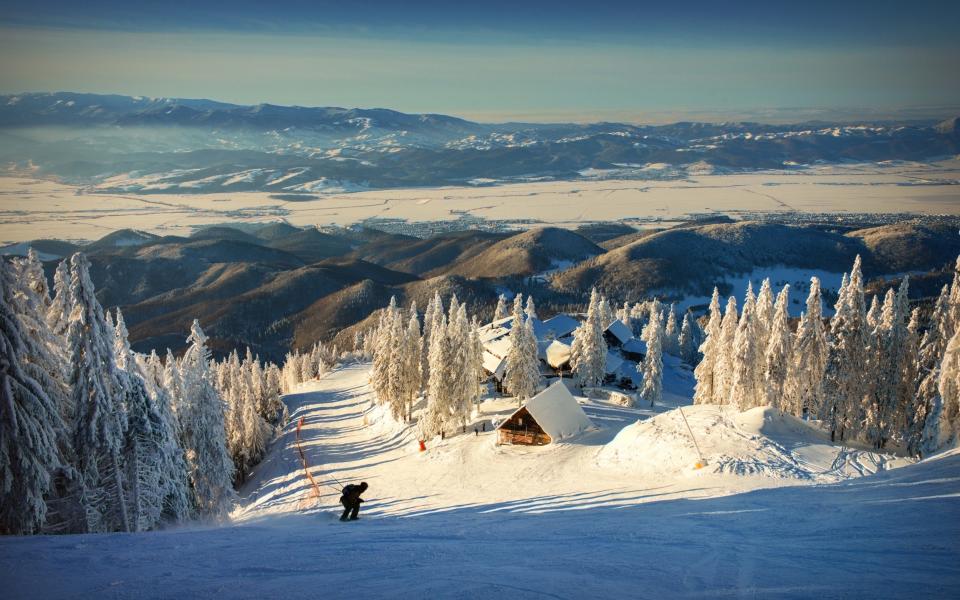
The 25km of pistes are served by modern lifts, the ski area is strictly for beginners and low intermediates – strong intermediates and experts will run out of slopes in a day. However, the 12 pistes are sufficient to keep novices busy for a week, lessons are cheap and the standard of tuition (usually in fluent English) in all three ski schools is high.
The biggest worry is snow cover, which rarely exceeds half a metre, and in a dry winter it can suffer badly at the start of a season that doesn’t extend beyond March. But a large chunk of the recent investment has been in snowmaking, and given low enough temperatures the main runs are now secure.
Where to stay
The four-star Ana Hotels Sport is at the foot of the slopes and has a pool, gym, sauna and outdoor hot tub as well as its own ski school and rental shop. The hotel houses Restaurant Altitude, and the Lobby Bar is one of the best spots in the resort for a coffee or a cocktail. From €1,274 (£1,104), B&B in a Twin Room Sport, which sleeps up to four, booked direct. Luton-Brasov return flights from £54 with Wizzair
Bansko, Bulgaria
Best for luxury
Luxury and ski resorts in Eastern Europe don’t normally go together, but Bansko is home to a choice of smart hotels. That said, they shouldn’t be compared with luxury standard accommodation in, say, Austria or Switzerland – this is very much the Bulgarian version. Bansko is two-and-a-half-hour drive south of Sofia airport, in the Pirin Mountains, close to the Macedonian and Greek borders. On a clear day there are views of the Aegean Sea.
The original town below the more recently constructed resort village features old stone buildings and cobbled streets and has always been popular with tourists. Bansko itself is a modern resort, with 75km of varied intermediate slopes covering two mountains and 16 lifts that include a six-person chairlift, four quad chairs and a gondola, which goes up to the main mountain from the top end of town.

Nursery slopes are reached from the gondola mid-station as well as at the top of the ski area, and higher up, there is enough to challenge intermediates for a week, provided snow conditions are good. However, the gondola is prone to heavy queues at peak times (which means it’s best to avoid visiting over Christmas and New Year) and the return journey to town is a 7km push down a blue path.
There is a lively, some might say wild, après scene, though. In the old town the utilitarian cafés and Dickensian-era shops that served the needs of local folk before mass tourism have been replaced by boutiques, wine bars and pizzerias. There are also plenty of traditional pubs called mehanas (often with live music). All in all, it’s a fun place.
Where to stay
Four-star Hotel Pirin is centrally located in Bansko. There’s a free shuttle bus to and from the lifts, and the hotel has an indoor swimming-pool, sauna, spa and gym. From £532, half board, including flights and transfers, with SNO.
Pamporovo, Bulgaria
Best for village charm
Just about every photo of Pamporovo features the ugly TV mast that dominates Snejanka, the high point of the ski area, but the village below has real rural charm and traditional ski resort appeal. It makes a great first or second winter-sports holiday without breaking the bank.
The resort is set in delightful Bulgarian countryside, 100km from the border with Greece and one hour and 45 minutes from the nearest airport at Plovdiv – this ancient city is a must-visit Unesco World Heritage site. The base of the slopes is a 10-minute ride from the main resort hotels, but there is an efficient free bus service.
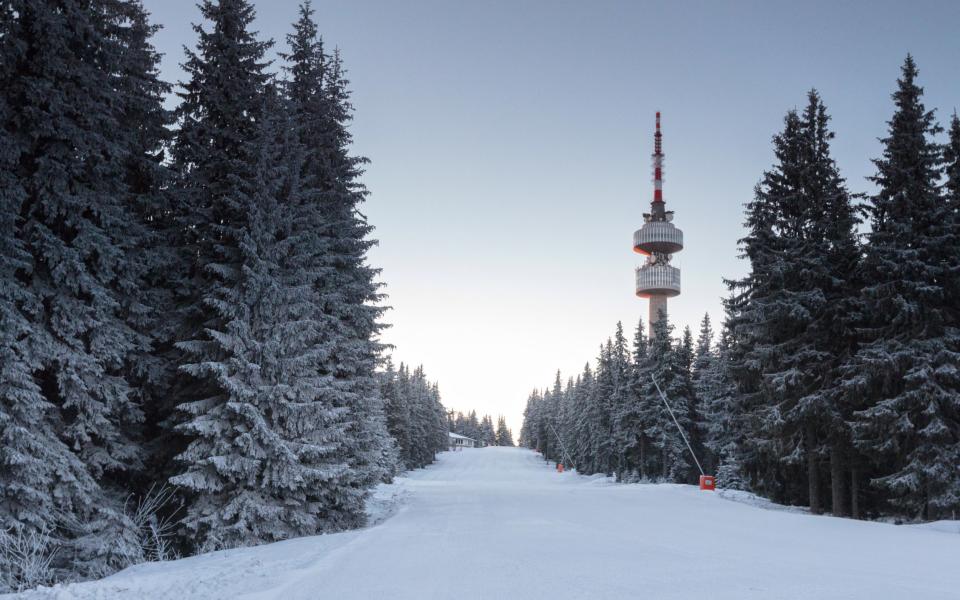
Most runs in the 36km ski area are green and blue. A handful of reds and obligatory blacks provide a goal for aspiring intermediates, but none of these present much of a challenge. The longest run of 4km, suitable for intermediates but not for beginners, goes down to the old village and the alternative accommodation base of Stoykite, located in blissfully tranquil surroundings.
Overall, tumbledown stone cottages, rolling meadows and forest form a pastoral symphony so sweet and enduring that the hamlet of Gela (6km away) is said to be the mythical birthplace of Orpheus. The local ski school has a solid reputation with lessons in English.
Pamporovo itself is lively at peak times, a party place with a couple of good restaurants and plenty of bars fuelled by some of the cheapest alcohol prices in Europe. As in other Eastern European resorts, snow cover can be uncertain, especially before Christmas and after mid-March, but snowmaking covers 90 per cent of the slopes.
Where to stay
Hotel Samokov was one of the resort’s first hotels and is a short distance to the nearest gondola. On site there is a pool and a spa area, fitness centre, bar and bowling alley. From £446, half board, including flights and transfers, with Crystal Ski.
Bohinj, Slovenia
Best for scenery
The ski resort of Bohinj is made up of several villages, set around the lake of the same name with its Vogel ski area above it. The nearby town of Bled, with its fairytale castle tends to hog the limelight as one of Slovenia’s top resorts. But while Bled has plenty of accommodation and acts a major bed base for the region, the main ski action is at a number of resorts served by regular ski bus from the town, and covered by the Julian Alps lift pass. These include Krvavec near Ljubljana airport, Kranjska Gora, Sella Nevea in Italy and Arnoldstein in Austria.

Some of the best intermediate ski action lies 27km away from Bled here at Bohinj and in another, even more beautiful, lakeside setting. Bohinj Vogel has its own separate lift pass. The Vogel ski area has 22km of pistes served by eight lifts, including long and wide blue runs help to boost beginners’ confidence, and there are red runs for intermediates. However, anyone more advanced will find the area rather limited. That said, Vogel’s snow park is among the best in Slovenia and suitable for all levels. Bohinj’s other ski area, Kobla is the country’s oldest, at the other end of the lake.
Hotels are scattered in the various villages and small towns around the lake. The largest of these is Bohinjska Bistrica which has a railway station. Overall Bohinj is a beautiful spot for a relaxed holiday in natural surroundings with a little gentle snow sport. It is not, however, the place for experts or for vibrant après ski.
Where to stay
Bohinj Eco Hotel is the first Green Globe-certified hotel in Slovenia. It is well placed, with bus access to the Lake Bohinj and Vogel ski areas. It’s more of a complex than a hotel, with a reputation for fine cuisine and plenty of activities such as a bowling alley, cinema, an extensive spa and Aquapark, with swimming pools and a climbing wall. From €1,470 (£1,273) per room, half board, travel not included, booked direct. Return Gatwick-Ljublijana easyJet flights from £84.
Unless stated otherwise prices are per person, for seven nights, based on two sharing, excluding travel.


